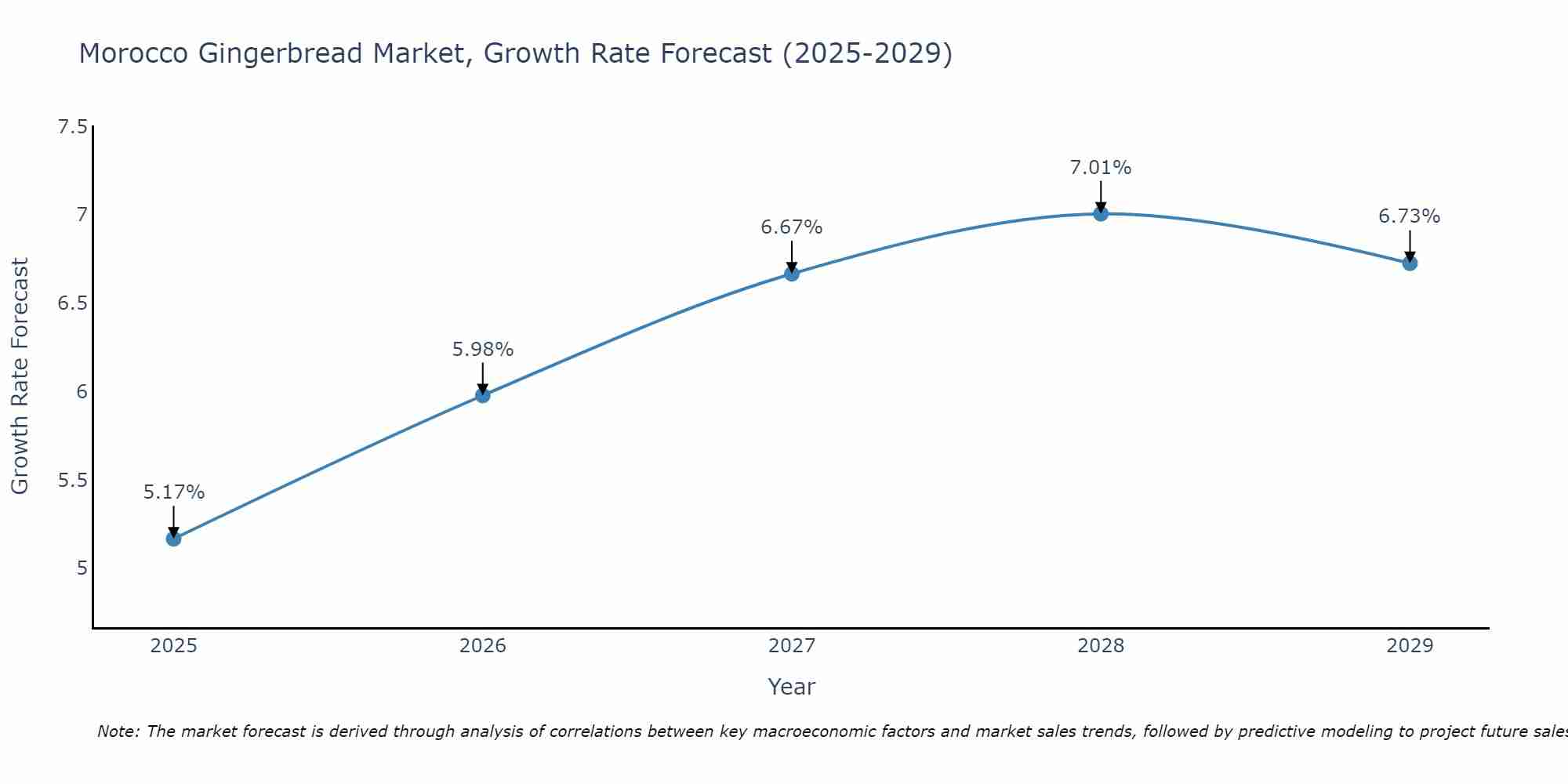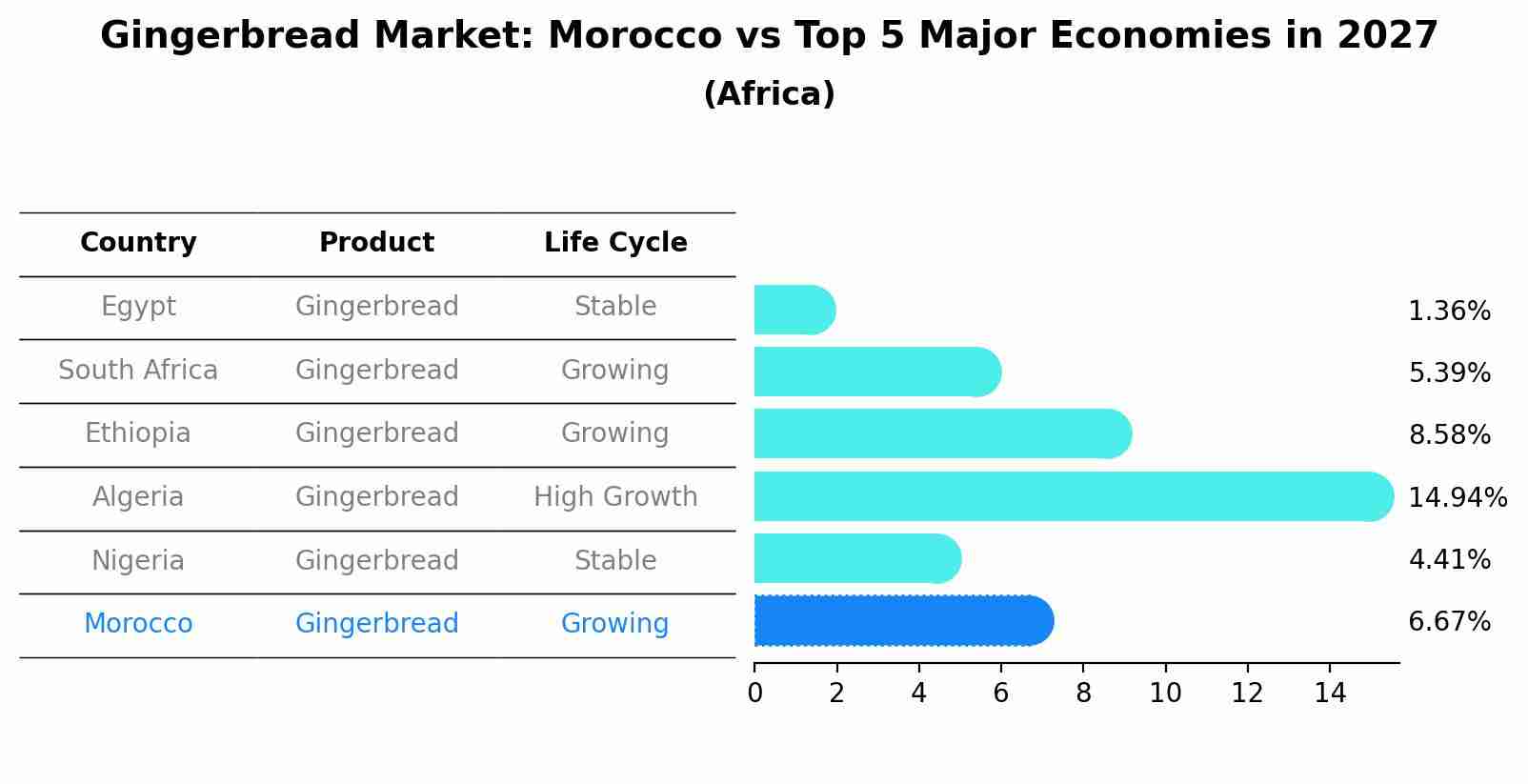Morocco Gingerbread Market Outlook | Trends, COVID-19 IMPACT, Industry, Share, Analysis, Companies, Growth, Value, Forecast, Revenue & Size
| Product Code: ETC410869 | Publication Date: Oct 2022 | Updated Date: Jul 2025 | Product Type: Market Research Report | |
| Publisher: 6Wresearch | Author: Shubham Deep | No. of Pages: 75 | No. of Figures: 35 | No. of Tables: 20 |
Morocco Gingerbread Market Size Growth Rate
The Morocco Gingerbread Market is projected to witness mixed growth rate patterns during 2025 to 2029. Starting at 5.17% in 2025, the market peaks at 7.01% in 2028, and settles at 6.73% by 2029.

Gingerbread Market: Morocco vs Top 5 Major Economies in 2027 (Africa)
The Gingerbread market in Morocco is projected to grow at a growing growth rate of 6.67% by 2027, highlighting the country's increasing focus on advanced technologies within the Africa region, where Egypt holds the dominant position, followed closely by South Africa, Ethiopia, Algeria and Nigeria, shaping overall regional demand.

Morocco Gingerbread Market Synopsis
The Morocco gingerbread market is a niche segment within the broader confectionery industry, known for its unique blend of spices and flavors. Gingerbread products are typically consumed during festive seasons and as traditional treats, popular during holidays like Ramadan and Eid. The market comprises a variety of gingerbread products such as cookies, cakes, and pastries, with a growing trend towards artisanal and premium offerings to cater to evolving consumer preferences. Key players in the market often leverage traditional recipes and local ingredients to create authentic gingerbread products that appeal to both domestic and international consumers. While the market size may be relatively smaller compared to other confectionery segments, there is potential for growth driven by increasing consumer interest in traditional and nostalgic treats, as well as the rising popularity of unique flavor profiles in the food industry.
Morocco Gingerbread Market Trends
In the Morocco gingerbread market, there is a growing trend towards healthier and more natural ingredients, with consumers seeking gingerbread products that are made with organic and locally sourced ingredients. There is also a rising demand for gingerbread variations that cater to specific dietary preferences, such as gluten-free, vegan, and sugar-free options. Artisanal and gourmet gingerbread products are gaining popularity among consumers looking for unique and high-quality offerings. Additionally, there is a trend towards innovative packaging and presentation of gingerbread products, especially during festive seasons and special occasions. Overall, the Morocco gingerbread market is experiencing a shift towards premium, health-conscious, and creatively packaged products to meet the evolving preferences of consumers.
Morocco Gingerbread Market Challenges
The Morocco Gingerbread Market faces several challenges, including increasing competition from imported gingerbread products, fluctuating prices of key ingredients such as ginger and spices, and limited awareness and appreciation of gingerbread as a traditional Moroccan treat. Additionally, the seasonal nature of gingerbread consumption poses a challenge for manufacturers in terms of maintaining consistent demand throughout the year. Moreover, the lack of standardized quality control measures and certifications in the gingerbread industry can hinder consumer trust and brand loyalty. To overcome these challenges, stakeholders in the Morocco Gingerbread Market may need to focus on product differentiation, marketing strategies to educate consumers about the benefits of gingerbread, and forming strategic partnerships to ensure a stable supply chain and pricing structure.
Morocco Gingerbread Market Investment Opportunities
The Morocco Gingerbread Market presents several investment opportunities for both local and international investors. With the growing trend of healthy and natural food products, there is a rising demand for organic and artisanal gingerbread in the market. Investors can capitalize on this trend by investing in gingerbread production facilities, sourcing high-quality organic ingredients locally, and creating unique flavor profiles to cater to the diverse tastes of consumers. Furthermore, exporting Moroccan gingerbread to international markets can also be a lucrative opportunity, especially to regions where there is a demand for exotic and gourmet food products. Collaborating with local artisans and promoting traditional Moroccan baking techniques can also add value to the product, attracting a premium price in the market. Overall, the Morocco Gingerbread Market offers a promising investment landscape for those looking to tap into the growing demand for natural and artisanal food products.
Jordan Agar Market Government Policies
Government policies related to the Morocco Gingerbread Market primarily focus on ensuring food safety and quality standards are met. The Moroccan government has regulations in place to oversee the production, packaging, and labeling of gingerbread products to protect consumer health and prevent deceptive practices. Additionally, there may be policies related to import and export regulations, tax incentives, and support for small-scale gingerbread producers to promote local industry growth. Compliance with these policies is essential for gingerbread businesses to operate legally and maintain consumer trust in the market. Overall, the government plays a key role in regulating the Morocco Gingerbread Market to uphold standards and support the industry`s development.
Morocco Gingerbread Market Future Outlook
The future outlook for the Morocco Gingerbread Market appears promising, with anticipated growth driven by increasing consumer interest in unique and exotic flavors, as well as a growing trend towards healthier and more natural ingredients. Gingerbread, with its blend of spices and molasses, offers a nostalgic and comforting appeal to consumers. Additionally, the rising popularity of food tourism and culinary experiences is expected to fuel demand for traditional Moroccan gingerbread varieties, known for their rich flavors and cultural significance. Manufacturers and producers in Morocco have the opportunity to capitalize on these trends by offering innovative product variations, such as organic or gluten-free options, and expanding distribution channels to reach a wider audience both domestically and internationally. Overall, the Morocco Gingerbread Market is poised for growth and diversification in the coming years.
Key Highlights of the Report:
- Morocco Gingerbread Market Outlook
- Market Size of Morocco Gingerbread Market, 2021
- Forecast of Morocco Gingerbread Market, 2031
- Historical Data and Forecast of Morocco Gingerbread Revenues & Volume for the Period 2018 - 2031
- Morocco Gingerbread Market Trend Evolution
- Morocco Gingerbread Market Drivers and Challenges
- Morocco Gingerbread Price Trends
- Morocco Gingerbread Porter's Five Forces
- Morocco Gingerbread Industry Life Cycle
- Historical Data and Forecast of Morocco Gingerbread Market Revenues & Volume By Application for the Period 2018 - 2031
- Historical Data and Forecast of Morocco Gingerbread Market Revenues & Volume By Household for the Period 2018 - 2031
- Historical Data and Forecast of Morocco Gingerbread Market Revenues & Volume By Commercial for the Period 2018 - 2031
- Historical Data and Forecast of Morocco Gingerbread Market Revenues & Volume By Distribution Channel for the Period 2018 - 2031
- Historical Data and Forecast of Morocco Gingerbread Market Revenues & Volume By Online for the Period 2018 - 2031
- Historical Data and Forecast of Morocco Gingerbread Market Revenues & Volume By Offline for the Period 2018 - 2031
- Morocco Gingerbread Import Export Trade Statistics
- Market Opportunity Assessment By Application
- Market Opportunity Assessment By Distribution Channel
- Morocco Gingerbread Top Companies Market Share
- Morocco Gingerbread Competitive Benchmarking By Technical and Operational Parameters
- Morocco Gingerbread Company Profiles
- Morocco Gingerbread Key Strategic Recommendations
Frequently Asked Questions About the Market Study (FAQs):
- Single User License$ 1,995
- Department License$ 2,400
- Site License$ 3,120
- Global License$ 3,795
Search
Thought Leadership and Analyst Meet
Our Clients
Related Reports
- Canada Oil and Gas Market (2026-2032) | Share, Segmentation, Value, Industry, Trends, Forecast, Analysis, Size & Revenue, Growth, Competitive Landscape, Outlook, Companies
- Germany Breakfast Food Market (2026-2032) | Industry, Share, Growth, Size, Companies, Value, Analysis, Revenue, Trends, Forecast & Outlook
- Australia Briquette Market (2025-2031) | Growth, Size, Revenue, Forecast, Analysis, Trends, Value, Share, Industry & Companies
- Vietnam System Integrator Market (2025-2031) | Size, Companies, Analysis, Industry, Value, Forecast, Growth, Trends, Revenue & Share
- ASEAN and Thailand Brain Health Supplements Market (2025-2031) | Strategy, Consumer Insights, Analysis, Investment Trends, Opportunities, Growth, Size, Share, Industry, Revenue, Segments, Value, Segmentation, Supply, Forecast, Restraints, Outlook, Competition, Drivers, Trends, Demand, Pricing Analysis, Competitive, Strategic Insights, Companies, Challenges
- ASEAN Bearings Market (2025-2031) | Strategy, Consumer Insights, Analysis, Investment Trends, Opportunities, Growth, Size, Share, Industry, Revenue, Segments, Value, Segmentation, Supply, Forecast, Restraints, Outlook, Competition, Drivers, Trends, Demand, Pricing Analysis, Competitive, Strategic Insights, Companies, Challenges
- Europe Flooring Market (2025-2031) | Outlook, Share, Industry, Trends, Forecast, Companies, Revenue, Size, Analysis, Growth & Value
- Saudi Arabia Manlift Market (2025-2031) | Outlook, Size, Growth, Trends, Companies, Industry, Revenue, Value, Share, Forecast & Analysis
- Uganda Excavator, Crane, and Wheel Loaders Market (2025-2031) | Strategy, Consumer Insights, Analysis, Investment Trends, Opportunities, Growth, Size, Share, Industry, Revenue, Segments, Value, Segmentation, Supply, Forecast, Restraints, Outlook, Competition, Drivers, Trends, Demand, Pricing Analysis, Competitive, Strategic Insights, Companies, Challenges
- Rwanda Excavator, Crane, and Wheel Loaders Market (2025-2031) | Strategy, Consumer Insights, Analysis, Investment Trends, Opportunities, Growth, Size, Share, Industry, Revenue, Segments, Value, Segmentation, Supply, Forecast, Restraints, Outlook, Competition, Drivers, Trends, Demand, Pricing Analysis, Competitive, Strategic Insights, Companies, Challenges
Industry Events and Analyst Meet
Whitepaper
- Middle East & Africa Commercial Security Market Click here to view more.
- Middle East & Africa Fire Safety Systems & Equipment Market Click here to view more.
- GCC Drone Market Click here to view more.
- Middle East Lighting Fixture Market Click here to view more.
- GCC Physical & Perimeter Security Market Click here to view more.
6WResearch In News
- Doha a strategic location for EV manufacturing hub: IPA Qatar
- Demand for luxury TVs surging in the GCC, says Samsung
- Empowering Growth: The Thriving Journey of Bangladesh’s Cable Industry
- Demand for luxury TVs surging in the GCC, says Samsung
- Video call with a traditional healer? Once unthinkable, it’s now common in South Africa
- Intelligent Buildings To Smooth GCC’s Path To Net Zero


















